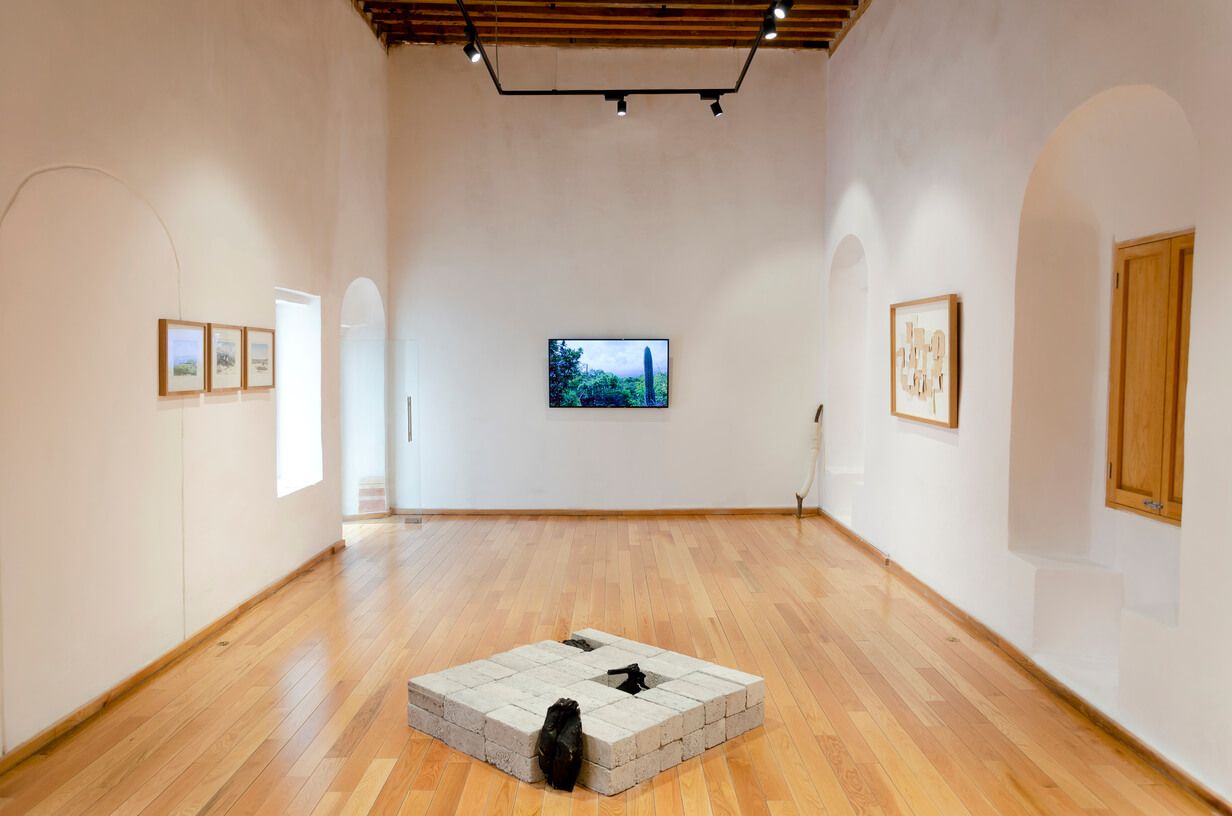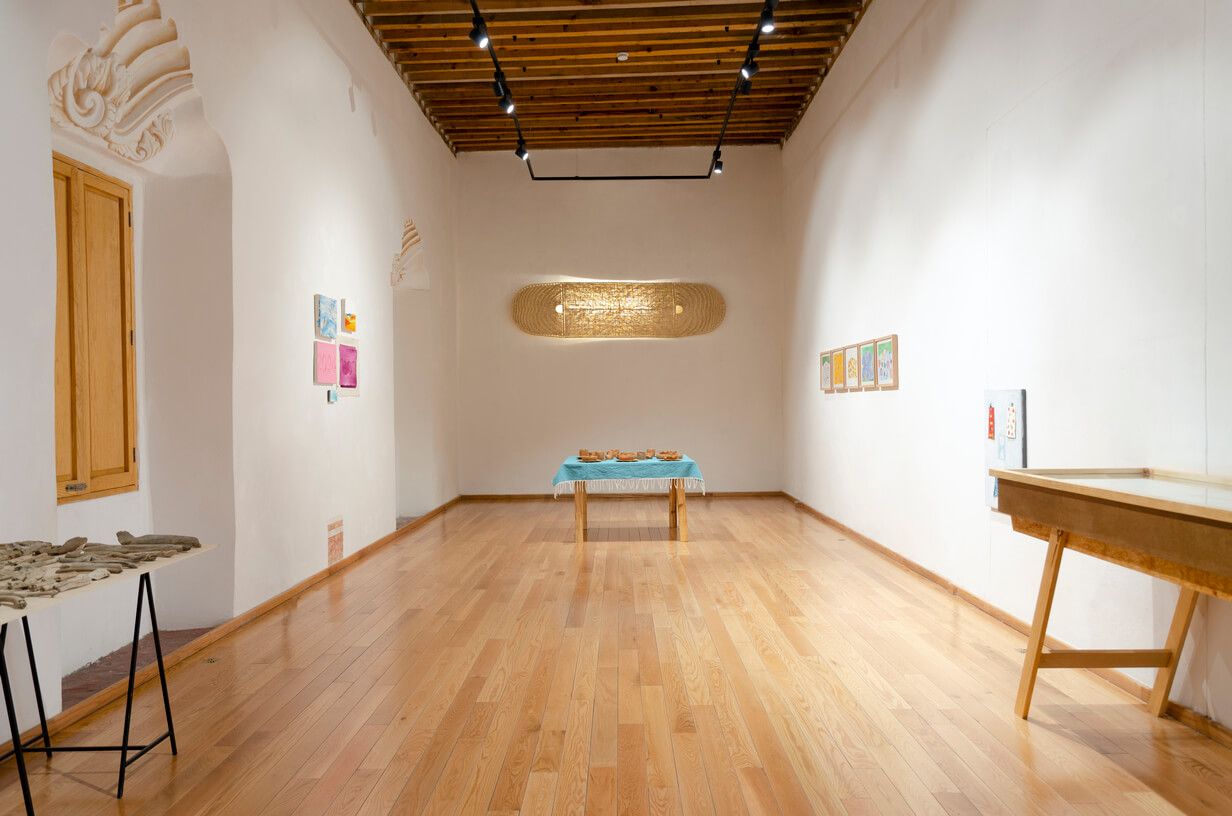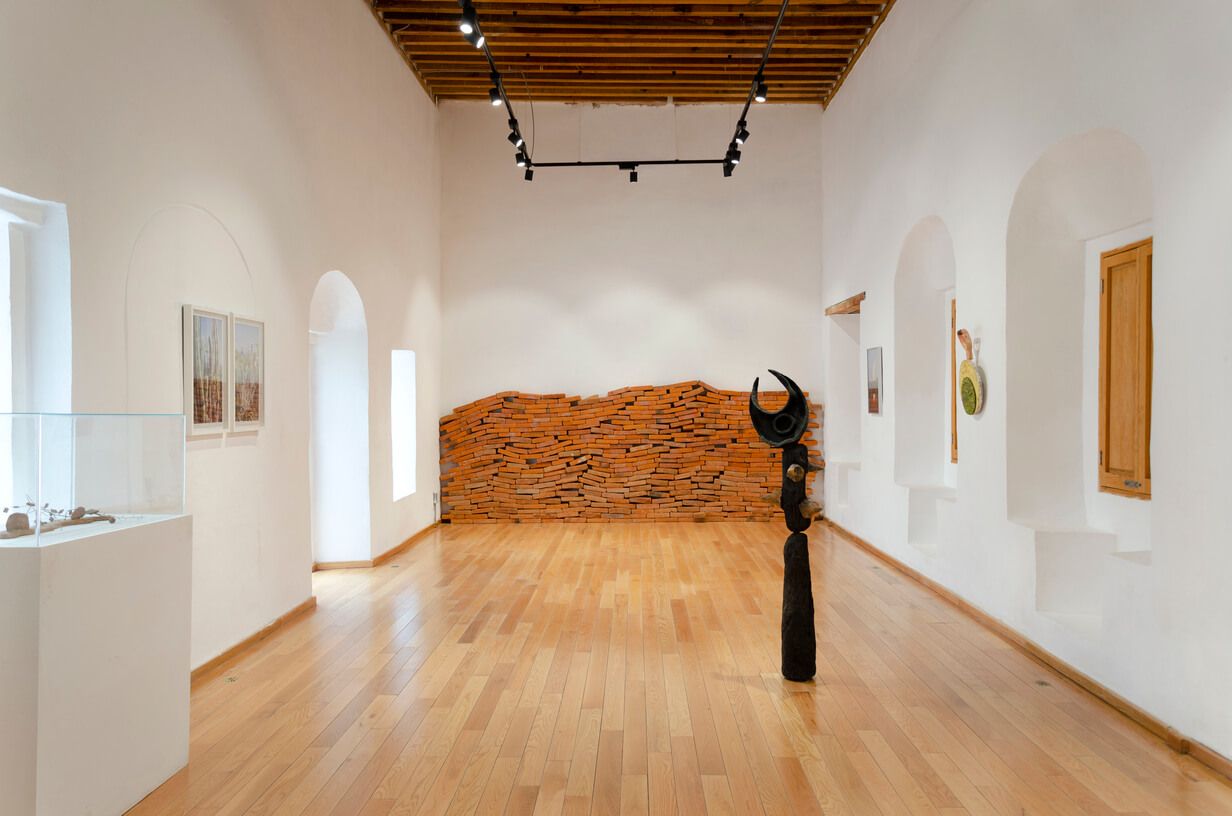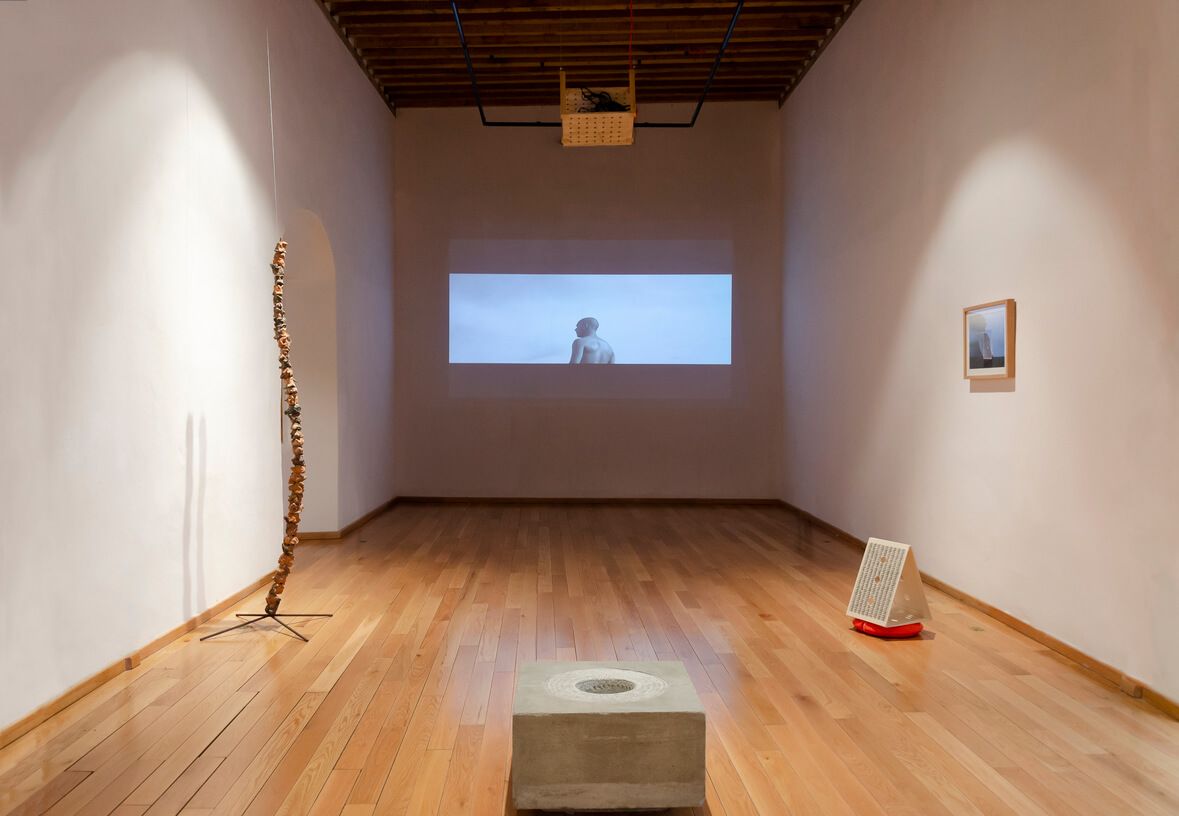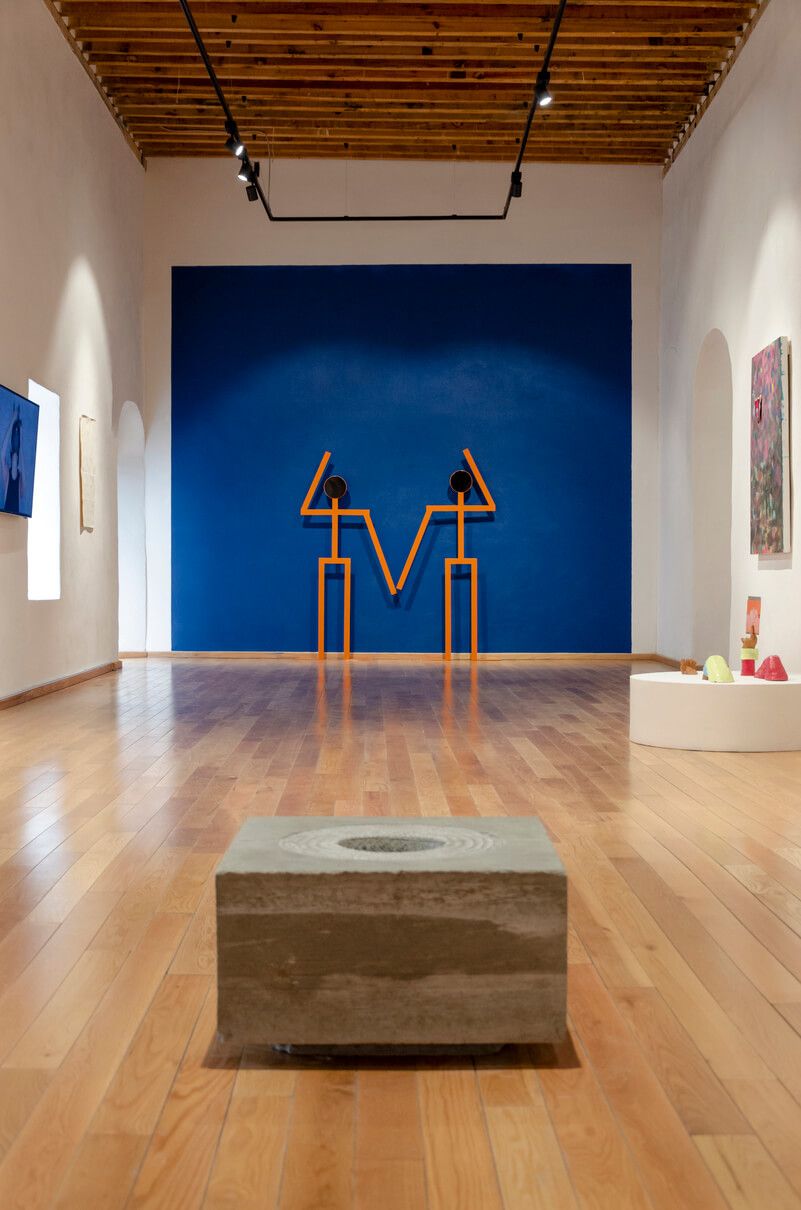Colaboración MACQ
Exhibition Bitácoras (Logs) presents a reflection of the creative life that originates in the residency program of Fundación Casa Wabi at its main venue in Puerto Escondido, Oaxaca. Vestiges of the multiple and diverse experiences of the artists in residence, the exhibition consists of 154 pieces by 66 national and international creatives who have been part of the program between 2014 and 2022.
Fundación Casa Wabi is a non-profit organization that fosters an exchange between contemporary art and local communities in three locations: Puerto Escondido, Mexico City and Tokyo. Founded by Bosco Sodi and Lucía Corredor, its mission focuses on forging social development through the arts, which it carries out through five key programs: residencies, exhibitions, clay, cinema and mobile library.
Aimed at artists and cultural actors, the residency program seeks to promote multidisciplinary encounters between different generations that stimulate their experimental and creative concerns, and contribute to the development of the social and cultural communities of the area. More than 350 artists and creatives have been received since its opening in October 2014, positioning itself as one of the residencies with the greatest impact on the national artistic work.
The residencies focus on the realization of projects that benefit communities in their access to art and culture. In parallel to the execution of the community projects, the artists produce during their stay a piece that is part of the Foundation’s collection.
In addition to directly manifesting the qualities and characteristics of the foundation, Bitácoras seeks to communicate the constant work that is done for the benefit of the communities, thus evoking the three key elements for the balance of the program: the creative inspiration of the residents, the interaction with other artists and the team of the foundation, and the active exchange with the local society.
Architecture
The architectural complex of Fundación Casa Wabi has been a constant source of inspiration for artistic creation. It is sought that each pavilion or building responds to one of the priorities of the mission of the foundation. In conjunction with the main venue in Puerto Escondido, which was designed by the Japanese architect Tadao Ando (Pritzker, 1995), a Clay Pavilion designed by the Portuguese architect Álvaro Siza (Pritzker, 1992) has been built. In addition to the Guayacán Pavilion built by the Mexican studio Ambrosi-Etchegaray, the Chicken coop by the Japanese architect Kengo Kuma, the Compost Pavilion by the Paraguayans Solano Benítez and Gloria Cabral, and more recently the High Temperature Oven and gardens by the Mexican architect Alberto Kalach. On the whole, the architectural development has served as a source of inspiration for artistic creation.
Located between the Pacific Ocean and the Sierra Madre del Sur, the landscape and nature in which the residence is located is prevailing in the daily dynamics of the residence. A cosmos far from the maelstrom of city life, the landscape becomes a refuge where artists find time to build an inner dialogue that eventually generates new ways of thinking. Interdisciplinary residencies offer participants a unique opportunity to focus on their work, while exploring, expanding and developing their practice in relation to their environment.
Community
The foundation fosters an exchange between the creativity of the artists and the way of life of the 14 communities with which we work. The interdisciplinary projects that are developed take many forms, as residents have complete freedom to propose positive ideas to their community groups. This sensitive dialogue succeeds when everyone shares knowledge, experiences and different ways of thinking. Community projects have been the origin of a series of works that investigate the relationship with the social conditions of the region.
The human body is fundamental to understanding the multiple facets of identity, such as gender, sexuality, race, and ethnicity. Residents explore gender through representations of the body and using their own bodies in relation to space, architecture and landscape. The use of their bodies in performances becomes a way both to claim control over their own bodies and to question issues of gender and identity.
Artists:
Yóllotl Alvarado (Mexico, 1989)
Tania Ximena (Mexico, 1985)
Aldo Álvarez Tostado (Mexico, 1987)
Lorena Ancona (Mexico, 1981)
Francisca Aninat (Chile, 1979)
Felipe Arturo (Colombia, 1979)
Javier Barrios (Mexico, 1989)
Félix Blume (France, 1984)
Tania Candiani (Mexico, 1974)
Sébastien Capouet (Belgium, 1989)
Isa Carrillo (Mexico, 1982)
Stjin Cole(Belgium, 1978)
Marilá Dardot (Brazil, 1973)
Marlon De Azambuja (Brazil, 1978)
Pablo De Laborde Lascaris (Mexico, 1985)
Adeline De Monseignat (Monaco, 1987)
Tomás Díaz Cedeño (Mexico, 1983)
Galia Eibenschutz 4 (Mexico, 1970)
Merike Estna (Estonia, 1980)
Carla Fernández (Mexico, 1973)
Claudia Fernández (Mexico, 1965)
Benjamín Torres (Mexico, 1969)
Michel François (Belgium, 1956)
Marita Fraser (Australia, 1969)
Terence Gower (Canada, 1965)
Jean Sébastien Gregoire (Canada, 1973)
Graciela Hasper (Argentina, 1966)
Nick Herman (United States,, 1973)
Madeline Jiménez, (Dominican Republic, 1986)
Margot Kalach (Mexico, 1992)
Iván Krassoievitch (Mexico, 1980)
Lake Verea / Francisca Rivero Lake (Mexico 1973) y Carla Verea (México, 1978)
Gonzalo Lebrija (Mexico, 1972)
Pedro Martinez Negrete (Mexico, 1984)
Francisco Ugarte (Mexico, 1973)
Nicólas Le Moigne (Switzerland, 1979)
Karla Leyva (Mexico, 1979)
Elsa Louise Manceaux (France, 1985)
Melanie Mclain (United States , 1983)
Fabiola Menchelli (Mexico, 1983)
Erick Meyenberg (Mexico, 1980)
Ad Minoliti (Argentina, 1980)
Raúl Mirlo (Mexico, 1985)
Guillermo Mora (Spain, 1980)
Francisco Muñoz (Mexico, 1986)
Roosmarijn Pallandt (Netherlands, 1977)
Daphane Park (United States, 1970)
Javier Peláez (Mexico, 1976)
Lucía Pizzani (Venezuela, 1975)
Gala Porras Kim (Colombia, 1984)
Calixto Ramírez (Mexico, 1980)
Mauricio Rico (Mexico, 1988)
Andrea Romero (Mexico, 1988)
Jorge Rosano (Mexico, 1984)
Mara Sánchez Renero (Mexico, 1979)
Ana Segovia (Mexico, 1991)
Santiago Sierra (Spain, 1966)
Bosco Sodi (Mexico, 1970)
Ernesto Solana (Mexico, 1985)
Tezontle / Lucas Cantu (Mexico, 1982) y Carlos Matos (Mexico, 1983)
Fabiola Torres Alzaga (Mexico, 1978)
Alejandra Venegas (Mexico, 1986)
Diego Vega Solorza (Mexico, 1990)
Carlos Vielma (Mexico, 1982)
Sue Webster (United Kingdom, 1967)
Richard Wentworth (United Kingdom, 1947)
Héctor Zamora (Mexico, 1974)
Fundación Casa Wabi is a non-profit organization that fosters an exchange between contemporary art and local communities in three locations: Puerto Escondido, Mexico City and Tokyo. Founded by Bosco Sodi and Lucía Corredor, its mission focuses on forging social development through the arts, which it carries out through five key programs: residencies, exhibitions, clay, cinema and mobile library.
Aimed at artists and cultural actors, the residency program seeks to promote multidisciplinary encounters between different generations that stimulate their experimental and creative concerns, and contribute to the development of the social and cultural communities of the area. More than 350 artists and creatives have been received since its opening in October 2014, positioning itself as one of the residencies with the greatest impact on the national artistic work.
The residencies focus on the realization of projects that benefit communities in their access to art and culture. In parallel to the execution of the community projects, the artists produce during their stay a piece that is part of the Foundation’s collection.
In addition to directly manifesting the qualities and characteristics of the foundation, Bitácoras seeks to communicate the constant work that is done for the benefit of the communities, thus evoking the three key elements for the balance of the program: the creative inspiration of the residents, the interaction with other artists and the team of the foundation, and the active exchange with the local society.
Architecture
The architectural complex of Fundación Casa Wabi has been a constant source of inspiration for artistic creation. It is sought that each pavilion or building responds to one of the priorities of the mission of the foundation. In conjunction with the main venue in Puerto Escondido, which was designed by the Japanese architect Tadao Ando (Pritzker, 1995), a Clay Pavilion designed by the Portuguese architect Álvaro Siza (Pritzker, 1992) has been built. In addition to the Guayacán Pavilion built by the Mexican studio Ambrosi-Etchegaray, the Chicken coop by the Japanese architect Kengo Kuma, the Compost Pavilion by the Paraguayans Solano Benítez and Gloria Cabral, and more recently the High Temperature Oven and gardens by the Mexican architect Alberto Kalach. On the whole, the architectural development has served as a source of inspiration for artistic creation.
Located between the Pacific Ocean and the Sierra Madre del Sur, the landscape and nature in which the residence is located is prevailing in the daily dynamics of the residence. A cosmos far from the maelstrom of city life, the landscape becomes a refuge where artists find time to build an inner dialogue that eventually generates new ways of thinking. Interdisciplinary residencies offer participants a unique opportunity to focus on their work, while exploring, expanding and developing their practice in relation to their environment.
Community
The foundation fosters an exchange between the creativity of the artists and the way of life of the 14 communities with which we work. The interdisciplinary projects that are developed take many forms, as residents have complete freedom to propose positive ideas to their community groups. This sensitive dialogue succeeds when everyone shares knowledge, experiences and different ways of thinking. Community projects have been the origin of a series of works that investigate the relationship with the social conditions of the region.
The human body is fundamental to understanding the multiple facets of identity, such as gender, sexuality, race, and ethnicity. Residents explore gender through representations of the body and using their own bodies in relation to space, architecture and landscape. The use of their bodies in performances becomes a way both to claim control over their own bodies and to question issues of gender and identity.
Artists:
Yóllotl Alvarado (Mexico, 1989)
Tania Ximena (Mexico, 1985)
Aldo Álvarez Tostado (Mexico, 1987)
Lorena Ancona (Mexico, 1981)
Francisca Aninat (Chile, 1979)
Felipe Arturo (Colombia, 1979)
Javier Barrios (Mexico, 1989)
Félix Blume (France, 1984)
Tania Candiani (Mexico, 1974)
Sébastien Capouet (Belgium, 1989)
Isa Carrillo (Mexico, 1982)
Stjin Cole(Belgium, 1978)
Marilá Dardot (Brazil, 1973)
Marlon De Azambuja (Brazil, 1978)
Pablo De Laborde Lascaris (Mexico, 1985)
Adeline De Monseignat (Monaco, 1987)
Tomás Díaz Cedeño (Mexico, 1983)
Galia Eibenschutz 4 (Mexico, 1970)
Merike Estna (Estonia, 1980)
Carla Fernández (Mexico, 1973)
Claudia Fernández (Mexico, 1965)
Benjamín Torres (Mexico, 1969)
Michel François (Belgium, 1956)
Marita Fraser (Australia, 1969)
Terence Gower (Canada, 1965)
Jean Sébastien Gregoire (Canada, 1973)
Graciela Hasper (Argentina, 1966)
Nick Herman (United States,, 1973)
Madeline Jiménez, (Dominican Republic, 1986)
Margot Kalach (Mexico, 1992)
Iván Krassoievitch (Mexico, 1980)
Lake Verea / Francisca Rivero Lake (Mexico 1973) y Carla Verea (México, 1978)
Gonzalo Lebrija (Mexico, 1972)
Pedro Martinez Negrete (Mexico, 1984)
Francisco Ugarte (Mexico, 1973)
Nicólas Le Moigne (Switzerland, 1979)
Karla Leyva (Mexico, 1979)
Elsa Louise Manceaux (France, 1985)
Melanie Mclain (United States , 1983)
Fabiola Menchelli (Mexico, 1983)
Erick Meyenberg (Mexico, 1980)
Ad Minoliti (Argentina, 1980)
Raúl Mirlo (Mexico, 1985)
Guillermo Mora (Spain, 1980)
Francisco Muñoz (Mexico, 1986)
Roosmarijn Pallandt (Netherlands, 1977)
Daphane Park (United States, 1970)
Javier Peláez (Mexico, 1976)
Lucía Pizzani (Venezuela, 1975)
Gala Porras Kim (Colombia, 1984)
Calixto Ramírez (Mexico, 1980)
Mauricio Rico (Mexico, 1988)
Andrea Romero (Mexico, 1988)
Jorge Rosano (Mexico, 1984)
Mara Sánchez Renero (Mexico, 1979)
Ana Segovia (Mexico, 1991)
Santiago Sierra (Spain, 1966)
Bosco Sodi (Mexico, 1970)
Ernesto Solana (Mexico, 1985)
Tezontle / Lucas Cantu (Mexico, 1982) y Carlos Matos (Mexico, 1983)
Fabiola Torres Alzaga (Mexico, 1978)
Alejandra Venegas (Mexico, 1986)
Diego Vega Solorza (Mexico, 1990)
Carlos Vielma (Mexico, 1982)
Sue Webster (United Kingdom, 1967)
Richard Wentworth (United Kingdom, 1947)
Héctor Zamora (Mexico, 1974)



